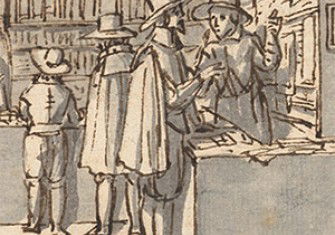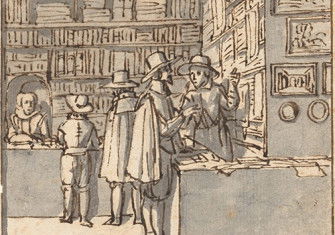Lives Laid Bare: Celebrity, Death and the Georgian Auction
Auctions, presided over by charismatic storytelling showmen, became social events in the 18th century, where middle-class Georgians could pick over the possessions of the dead and see close up the tactile relics of celebrity.
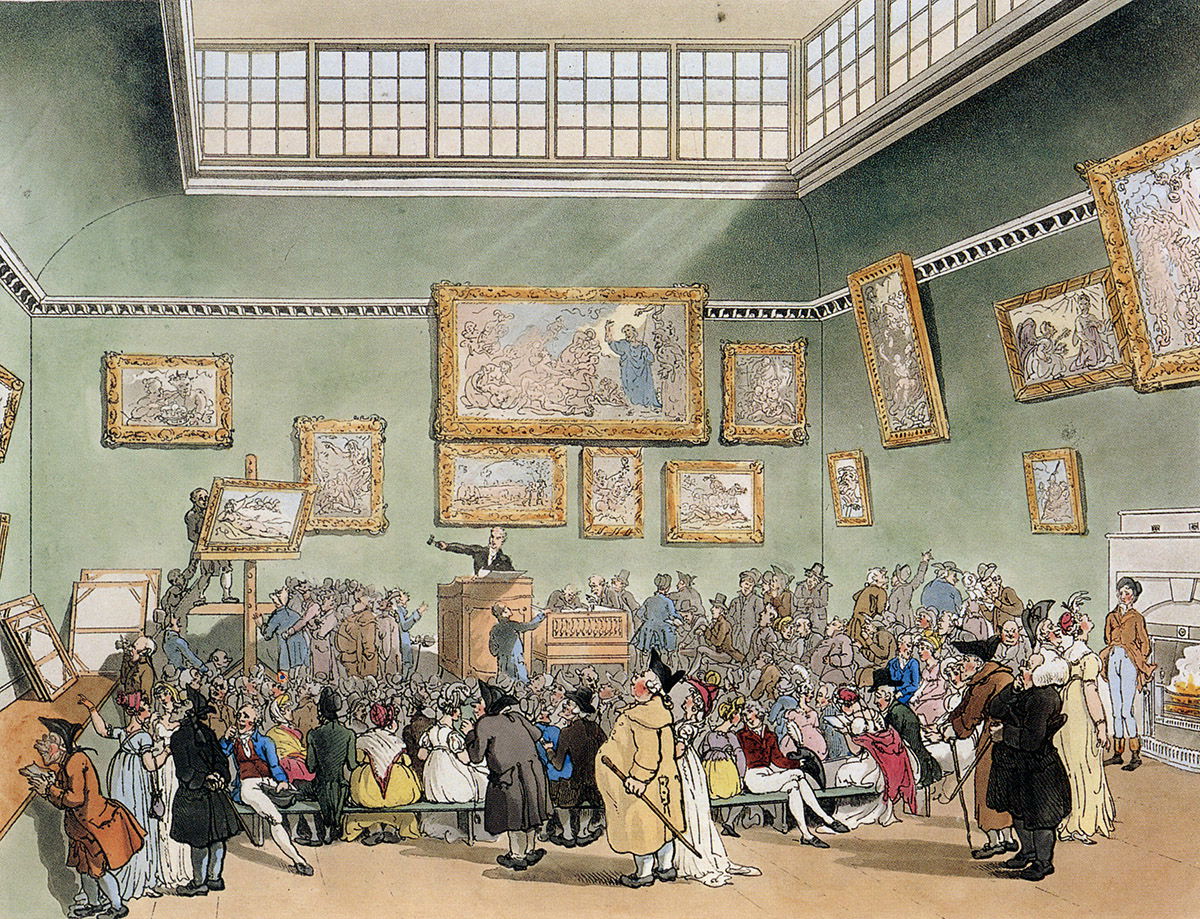
Christie's Auction Rooms, engraving from 'The Microcosm of London' published by Rudolph Ackermann, 1808.
In her 1782 novel Cecilia, Frances Burney sends her eponymous young heroine to a London auction. Such sales were hugely popular in Georgian England and attracted vast crowds, who gathered to gawp at (and participate in) the unfolding spectacle. Cecilia is warned by a friend;
All the world will be there ... there’ll be such a monstrous crowd as you never saw in your life. I dare say we shall be half squeezed to death.
Later in the novel, Cecilia’s friend describes a public sale that dismantled the household effects and treasures of one deceased Lady Belgrade, exposing the contemporary fascination with private, aristocratic lives, as well as deep-rooted anxieties about the value of a deceased person’s belongings in a commercial market place;
All the wardrobe was sold, and all Lady Belgrade’s trinkets. I never saw such a collection of sweet things in my life. I was ready to cry that I could not bid for half a hundred of them … Poor Lady Belgrade! You really can’t conceive how I was shocked for her. All her beautiful things sold for almost nothing.
Such sales, through their ubiquitous popularity, were able to manipulate an audience’s emotions, shape their desires and dictate their tastes. The auction was a place to see, but also to be seen. Today’s modern auctions are clearly related to their 18th-century ancestors – Sotheby’s was founded in 1744 and Christie’s in 1766. Some of the most famous and large-scale sales around the world owe their fixation with celebrity and their ability to set trends and dictate desires to the auctions of the Georgian period. Auctions were concerned with revealing and reinventing the lives of prominent social figures. They often took place following the death or bankruptcy of a person, usually someone from the wealthier ranks of society who had owned goods worth selling. Auctioneers regularly doubled as cabinet- and coffin-makers, with their cabinets housing the goods of the dead and their coffins the bodies. There was a physical as well as economic connection between death and the auction.
*
What could we expect to see at an 18th-century auction? Sales often took place in taverns or coffee houses, where the goods of middle class clients would be sold to a mainly male audience. Towards the later Georgian period, bidding started to take place in more professionalised spaces, such as newly designated auction houses, or even in the homes of the wealthy. In 1755, the artist Jean-Andre Rouquet described in his book, The Present State of the Arts in England, the performative nature of the auction from the viewpoint of a bidder in the audience:
The auctioneer mounts with a great deal of gravity, salutes the assembly, and prepares himself a little, like an orator, to perform his office with all the gracefulness and eloquence of which he is master. He takes his catalogue, he orders his servants to present the first article, which he declares aloud; in his hand he holds a little ivory hammer, with which he strikes a blow on the rostrum, when he thinks proper to signify to the company that the article put up to sale is determined.
Along with the influx of luxury goods into the Georgian market, including fine teas and wine, ceramics created by Spode and Wedgwood, furniture by Chippendale and furs brought to Britain by the Hudson’s Bay Company, came developments in more specific and self-conscious selling spaces. The Georgian revolution in shopping provided new experiences for the avid consumer, with goods laid out in visually appealing and sensuous ways, while publications such as Rudolph Ackermann’s monthly periodical The Repository for the Arts, Literature, Commerce, Manufactures, Fashion and Politics (1809-28) instructed people in how to shop. The sites for trading and purchasing became more luxurious, as the street stalls of the Middle Ages were rapidly replaced with covered arcades and shops with fitted glazed windows. It is within this context of a growing and sophisticated marketplace that we can understand the experience of the auction.
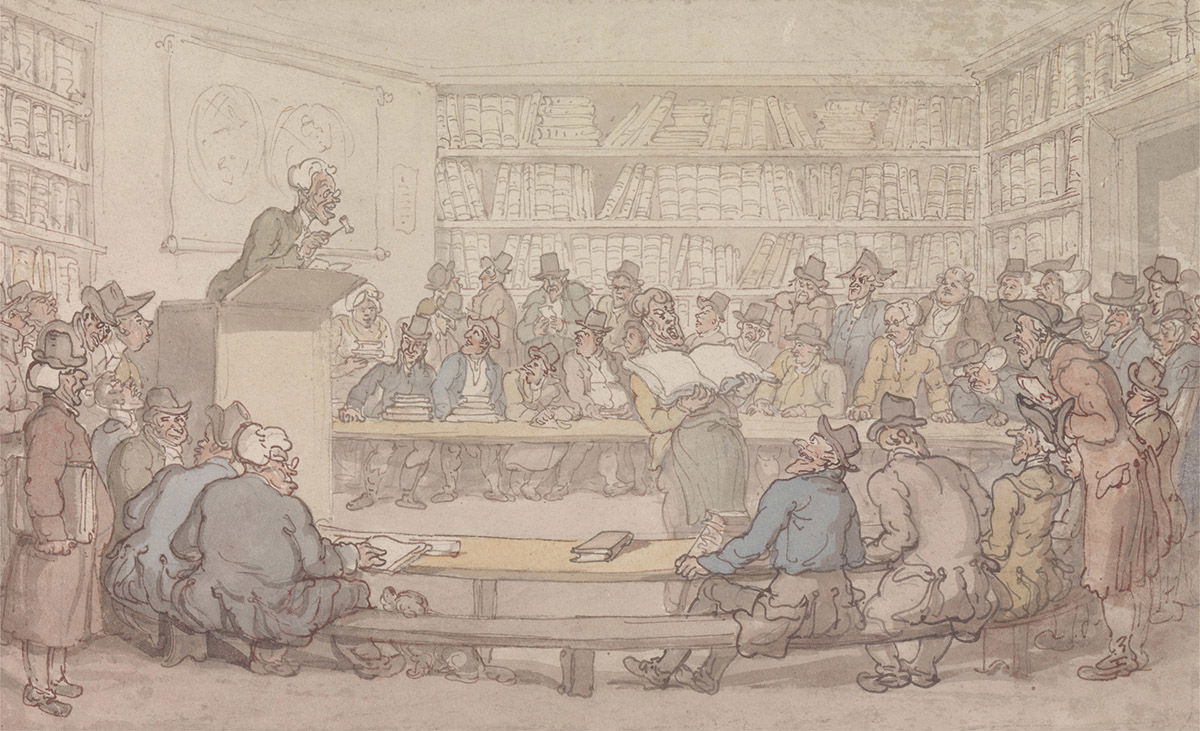
There, a newly moneyed mercantile middle class, with wealth drawn from manufacturing and trade goods as the early industrial revolution began to gather momentum, could mingle with the Georgian aristocracy as they looked at, touched and even smelled the goods on offer. Such tactile experiences naturally invited conversation. Potential buyers could pause over goods, inspecting them and discussing their merits with friends and strangers alike. In his later book Memorials of Mr. Christie (1897), William Roberts described how at the 18th-century auction ‘it was at one time the fashion for persons of quality to frequent sales and make purchases for themselves’ and lists among regular auction-goers Samuel Johnson, the duchess of Portland, Lady Bute, Lord Fitzwilliam, Lady Weymouth and Sir Joseph Banks.
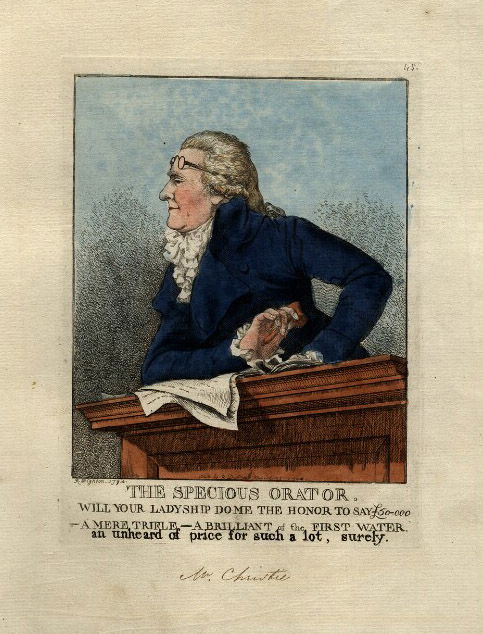
The auction was a profitable business for the auctioneer. Historian Troy Bickham has estimated that ‘auctioneers typically kept 7.5 per cent of the takings as their fee’. With this came the rise of the celebrity auctioneer. Noted for singular qualities such as loquaciousness, charm, polite manners, morality and oratory ability, an auctioneer’s fame could influence the success of a sale and command the obedience of the crowds. Robert Dighton’s rendering of James Christie as the ‘Specious Orator’ depicted the auctioneer equipped with the traditional apparatus of his trade, leaning somewhat lasciviously into the audience, with whom he appears to be in dialogue. Dighton imagined Christie’s speech as he attempts to charm an aristocratic woman from her money: ‘Will your Ladyship do me the honour to say £50-000 – A mere trifle – A brilliant of the first water. An unheard of price for such a lot, surely.'
The auctioneer was required to construct and, crucially, control the narrative of the sale as it unfolded in real time. While a catalogue and other printed ephemera might pre-ordain the tone and structure of an auction, it was the auctioneer who set its pace and maintained its rhythm. The success of each event depended almost entirely on the character, or personality, of the auctioneer; charisma and eloquence were paramount, while truth and reality were, to some extent, irrelevant within the carefully constructed environment of the auction room. In ‘A Elegy on the death of Mr. Edward Millington, the Famous Auctioneer’, the poet Tom Brown quipped:
Mourn, Mourn, you Booksellers, for Cruel Death
Has robb’d the famous Auctioneer of Breath…
No more will he now at your Service stand
Behind the Desk, with Mallet in his hand…
‘Come, gentlemen, come, bid what you please,
Upon my word it’s a curious piece;
Done by a learned hand, and neatly bound,
What say you? Come, I’ll put it up one pound
Often auctioneers could advance their position within fashionable society as a direct result of their work. James Christie, for example, rented rooms in Pall Mall where he shared the building with the Royal Academy of Arts, ensuring that he benefitted from its prodigious patrons attending exhibitions there. Thomas Skinner, a prolific auctioneer largely forgotten by modern historians, cut a similarly respectable figure. The biographer Theophilus Quin wrote of Skinner in his 1821 Biographical Exemplar, ‘there is scarcely a corner of the kingdom that has not experienced the weight of his hammer, which, like a magician’s wand, could transfer the land from one owner to another’. According to Quin, Skinner had ‘attained almost unprecedented celebrity in this line, and acquired more wealth than any auctioneer of former times’.
*
But the auctioneer was not the auction’s only star. He shared a billing with the person whose belongings were to be sold. In the late-Georgian period, public sales of aristocratic estates were the subject of satire, as the processes of the auction regularly exposed familial discord, private friendships and financial difficulties. During the summer of 1819, Christie sold at auction a large portion of Queen Charlotte’s belongings. The prolific satirical artist George Cruikshank captured the exquisite combination of public speculation and private embarrassment that such events provoked in his Sales By Auction! In it, Charlotte’s children are shown as greedy, gluttonous offspring, eager to sell their mother’s belongings for a profit. At the centre of the scene, the infamously decadent and endebted Prince Regent touts on tip-toe from his stand: ‘Poor soul she died very poor having given away all her money to charity. So pray my good people, Bid Liberally or the children will be destitute.’
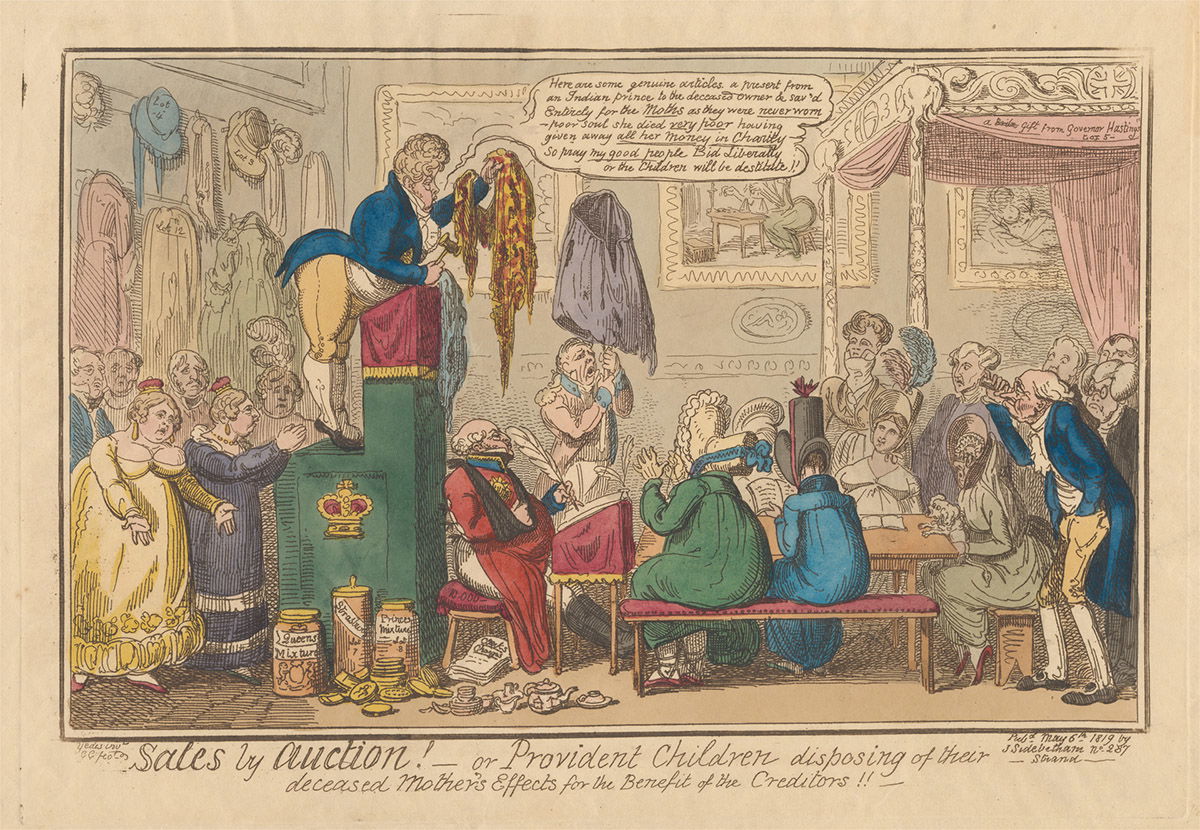
As with Christie’s sale of Queen Charlotte’s things, auctions could tell a story, or give an impression (albeit prescribed), of people or places previously unknown to a middle-class buying public. If auctions told a story, their sale catalogues were the texts that recorded and shared them. Narrative was set down ahead of the bidding and usually printed and sold days, even weeks, in advance. These texts would be sold in taverns and coffee houses, at the site of the auction and the auctioneer’s offices. These texts would include a title page and sometimes a preface or short essay about the goods being sold or the life of the previous owner, as well as practical information on when, where and how to bid, and a list of items for sale. The title page of these catalogues often doubled as a poster that would be displayed ahead of the sale and which delighted its readers with promises of the action to come. As sales became more successfully and widely advertised, so their audiences became more diverse and engaged. While competitive bidding was still the preserve of the wealthiest attendants, anyone who could afford the relatively modest entrance fee might attend. Most often, visitors to auctions selling the goods of deceased or bankrupt celebrities had predominantly come to gawp at their personal effects, laid bare for public delectation.
One of the most high profile auctions of the 18th century took place over 38 days and served to dismantle the private collection assembled by Margaret Cavendish Bentinck, Duchess of Portland (1715-85), who had died some months earlier. Her collection, representing a lifetime of voracious collecting, was known as the Portland Museum. It was made up of shells, botanical specimens, treasures from ancient Rome and artworks by Renaissance masters. The ‘museum’ – a term commonly used to describe early private collections as well as the public institutions that characterised the late Georgian period – had previously been housed at her Buckinghamshire estate, Bulstrode Park. Following her death, however, it was removed to London where fictionalised narratives of her celebrity, cultivated after her death, helped drive the commercial success of the sale. Gossip grew in the preceding weeks, with the topics of both public and private speculation including the reasons for the sale itself, what would be sold there and who would buy what. For example, in 1786 the collector, writer and antiquarian Horace Walpole wrote in a letter to his cousin:
Mr Horace Walpole (not myself) called on me yesterday morning, when no will of the Duchess of Portland has been found. He thinks the bulk of the collection will be sold, but that the Duke will reserve the principal curiosities – I hope so, for I should long for some of them, and am become too poor to afford them.
The sale was preceded by an exhibition, for which the auction catalogue doubled as an entrance ticket. Taking place in the duchess’ townhouse in Privy Gardens, Whitehall, the sale was widely reported in daily newspapers and periodicals alike. As early as 11 February, the Morning Post intrigued its readers with promises of a ‘most copious and splendid collection’ which, the paper touted, contained among its legions of specimens ‘insects’, ‘corallines’, ‘petrifactions’, ‘snuff boxes’, ‘pictures and prints’, ‘old china’ and Greek and Roman sculptures including the head of Jupiter Serapis and the widely celebrated Barberini, later Portland, Vase.
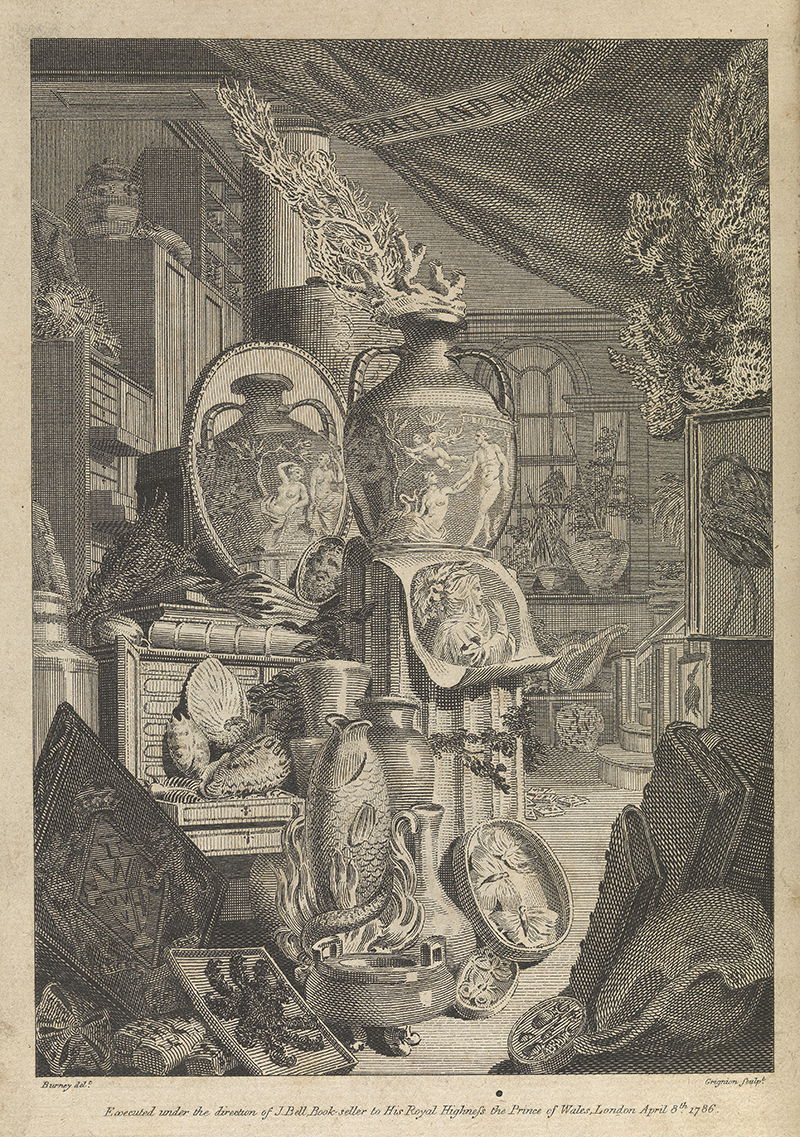
By the latter half of the century, the private cabinets of the elite were increasingly being dismantled in an age of commercial revolution. Sir Ashton Lever’s museum, known as the Leverian, was partially sold via lottery tickets in 1784, while 1786 saw the destruction of the Portland Museum. With increasingly regularity, this was to become the widespread fate of the connoisseur’s cabinet; in 1793 Horace Walpole exclaimed in a letter: ‘Who knows how soon my playthings may fall under Mr Christie’s hammer!’ On 24 April, a report from the Morning Chronicle revealed the popularity of the Portland Museum’s sale, as well as the importance of the catalogue in selling notions of the post-mortem celebrity of the duchess and the value of her museum:
The crowds at the Portland Museum for the last few days have been such as made all the rooms very inconvenient ... The numbers of catalogues already sold is far beyond all expectation; seventeen hundred or more were reported to us on Friday … The number of people that attended the Duchess of Portland’s Museum on Saturday last (being the last day of viewing) is scarce to be credited; the rooms were at once so exceedingly hot and crowded, that several ladies fainted. The sale begins this day, and in what room the auctioneer is to exhibit, our correspondent knows not, but is satisfied that the largest room in that house is much too small to contain half the persons who would wish to attend as purchasers.
The Morning Herald’s reporter also captured, with a degree of satire, the crowded chaos of the sale and its cornucopia of curiosities:
The Dutchess [sic] of Portland’s Museum was on Saturday crowded in an uncommon degree; some of the most interesting remarks in this miscellaneous assembly were, – ‘In which room is the walking oyster to be seen?’ – ‘Where do they keep the Phoenix’s nest with the seven young ones?’ – ‘I want to have a peep at the white black-bird.’ – ‘Let me come by to see that flying lobster!’ – ‘They tell me there are a pair of shells of so curious a nature that there is only one in the universe.’ – ‘Who had seen the pieces of live marbles’ – ‘What I would not give to see the nipples of the suckling fish!’
The accompanying catalogue allowed for active and personal engagement with the duchess’ collection and, by extension, the duchess herself. Her life, laid out in the text via a series of objects, was interpreted and augmented with annotation and illustration.
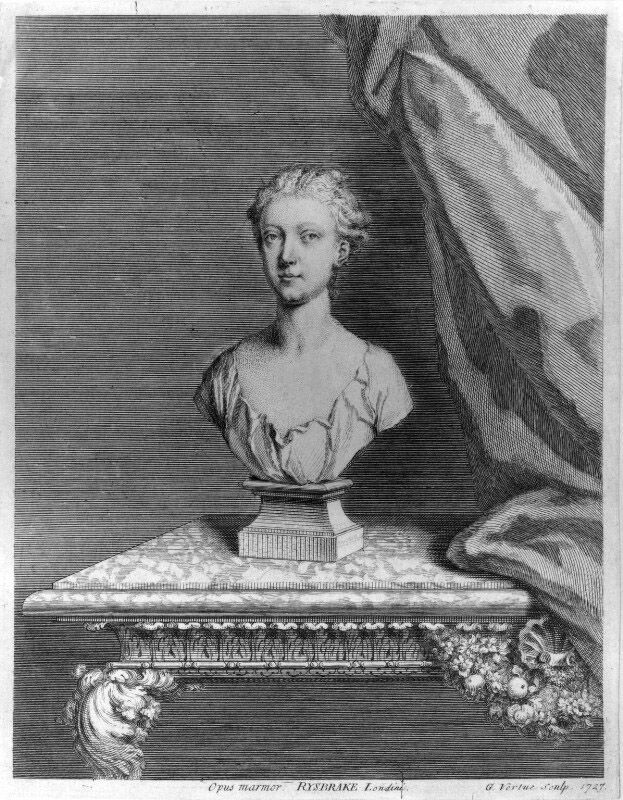
The auction’s catalogue offered a completely artificial reality; one in which narrative was cultivated and where the purchaser felt invested in and a contributor to the collection. It acted as a self-assembled album or memento of the sale. One could buy illustrations and prints to stitch or bind into the original sale text. On 25 April, The Morning Herald advertised ‘A Portrait of the late Dutchess Dowager of Portland, from a Marble Bust, executed by Rysbrack.’ Sold by the print maker George Humphrey at a cost of 1s 6d (relatively affordable for the middle- and upper-class auction-goers) this engraving was produced in quarto, matching the size and shape of the catalogue and suggesting that, despite being made and sold separately from the sale text, it was intended to speak to and even be inserted inside it. This image was quickly circulated among those interested in the sale – despite the fact that the bust itself was sculpted in 1727 and depicted the duchess at the age of 12. Similarly, engravings showing the penultimate lot of the sale, and the museum’s most famous object – the Portland Vase – were sold to bidders and regularly inserted inbetween the pages of the catalogue. To own this Roman treasure, even as paper and ink, was to cultivate and display one’s good taste.
*
Although auctions undoubtedly took place in Britain in the 17th century and possibly earlier, these were small-scale, localised and largely unambitious affairs. It was the auction of the 18th century that professionalised its processes, opening it up to a new, commercially engaged public and infusing it with narrative and drama. Simultaneous explosions in print culture and commercial and mercantile expansion provided an ideal climate in which the auction flourished. As Britain began to reimagine itself through its expanding empire, and the object encounters that inevitably accompanied it, the auction offered an arena in which to negotiate shifting social, economic, art historical and aesthetic norms.
The Georgian auction, then, was central in shaping the tastes of the market, one that traded on the infiltration and reinterpretation of the collections and lives of the upper classes. It provided access to the private spaces, concerns and habits of an elite group of people who, usually through their deaths or financial difficulty, could be reinvented on the public stage; their belongings passing under the judicial hammer of the auctioneer and before the eyes of a curious public. Auctioneers like Thomas Skinner and James Christie served as measurers of cultural value, dictating taste to their bidders. These events retold old histories as new stories, feeding a hungry press emerging from the growing industry of printed media, as well as an eager and paying public. They were dramatic purveyors of spectacle and were part of other fashionable urban entertainments in this period, frequented by the same people who attended the newly designed theatres, pleasure gardens and museums of British cities.
Madeleine Pelling is a PhD candidate at the University of York, exploring the collection of antiquities and natural history specimens assembled by Margaret Cavendish Bentinck, duchess of Portland (1715-1785).



